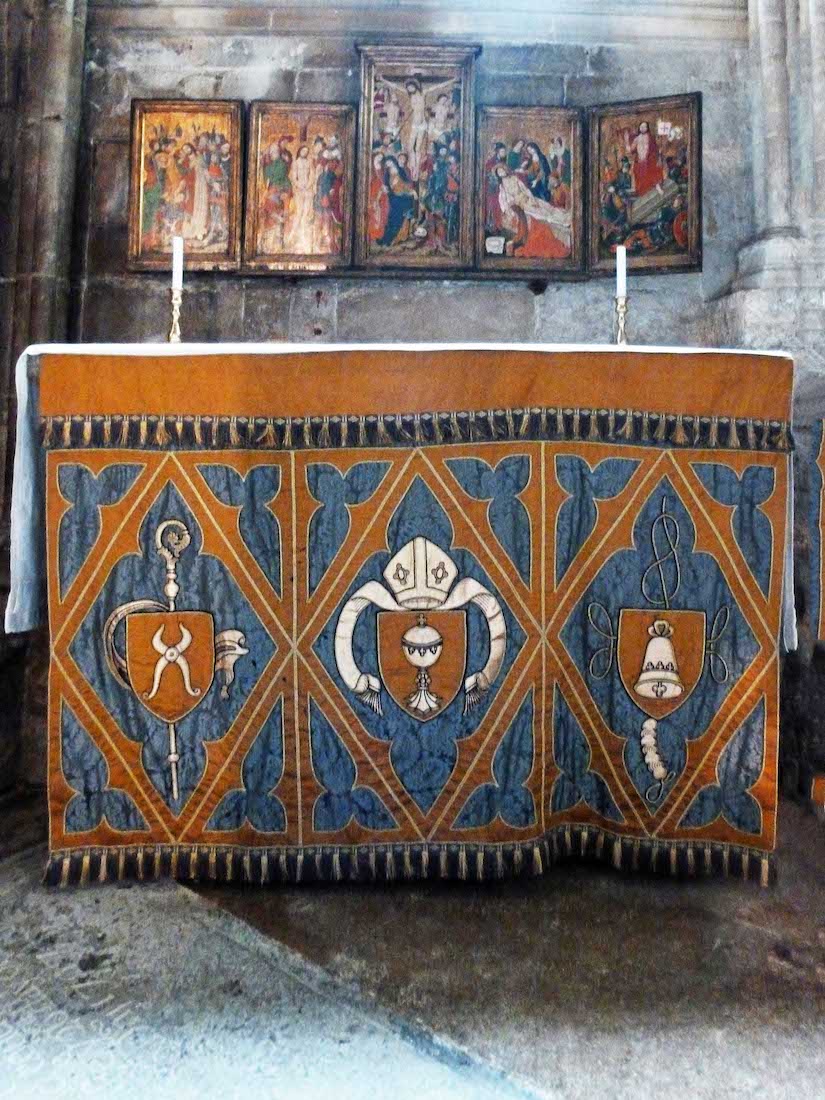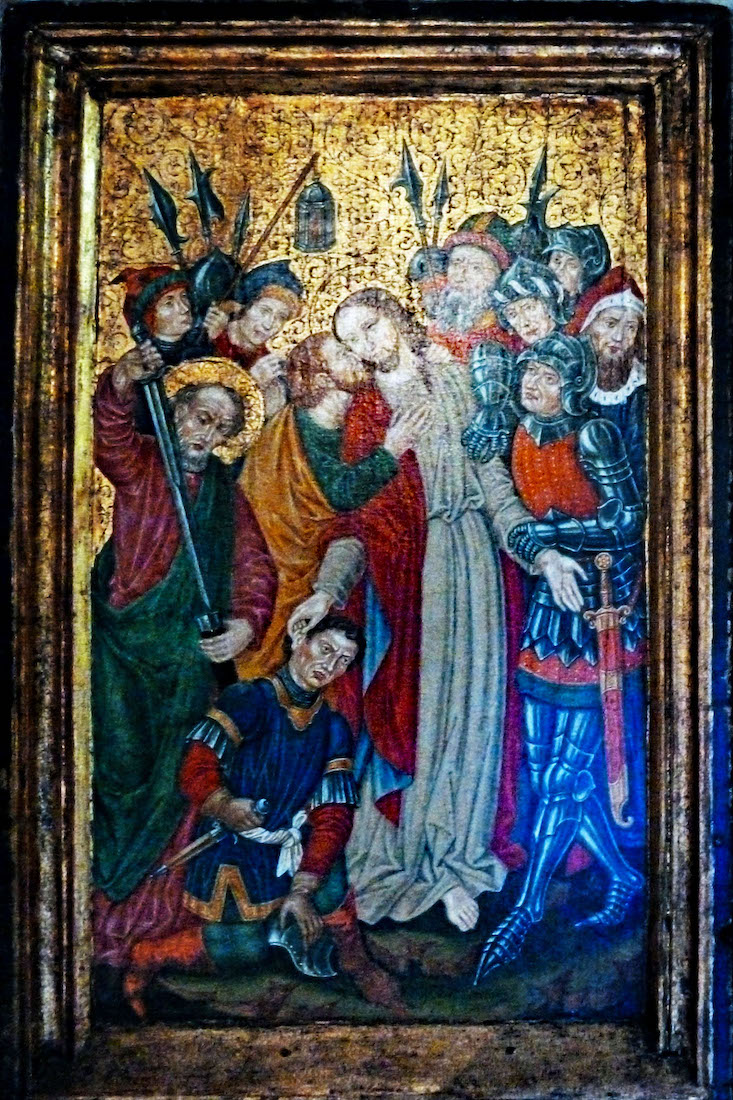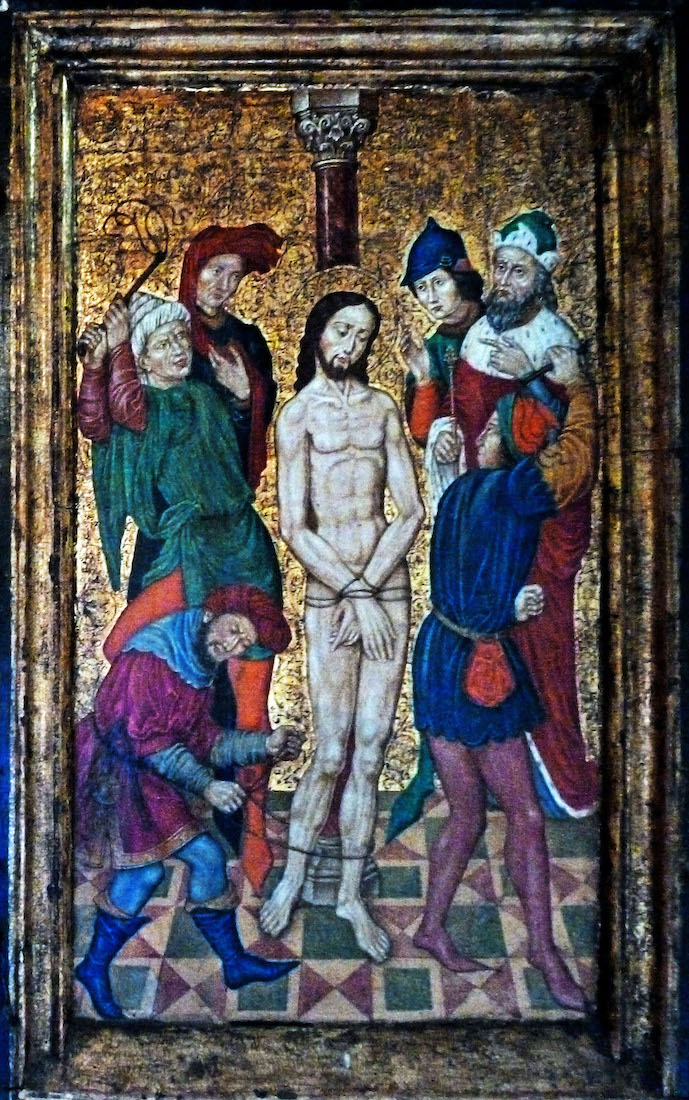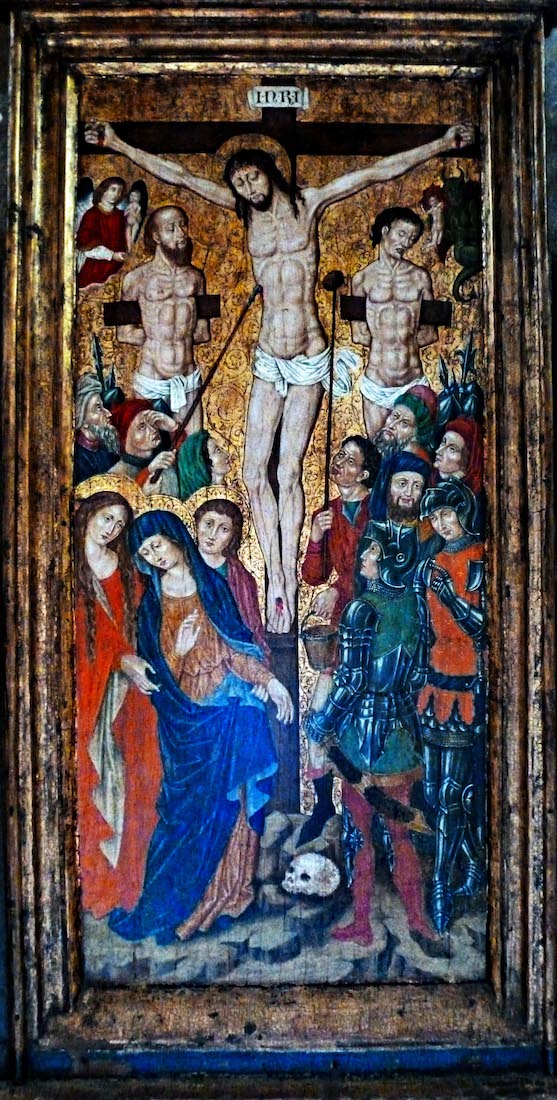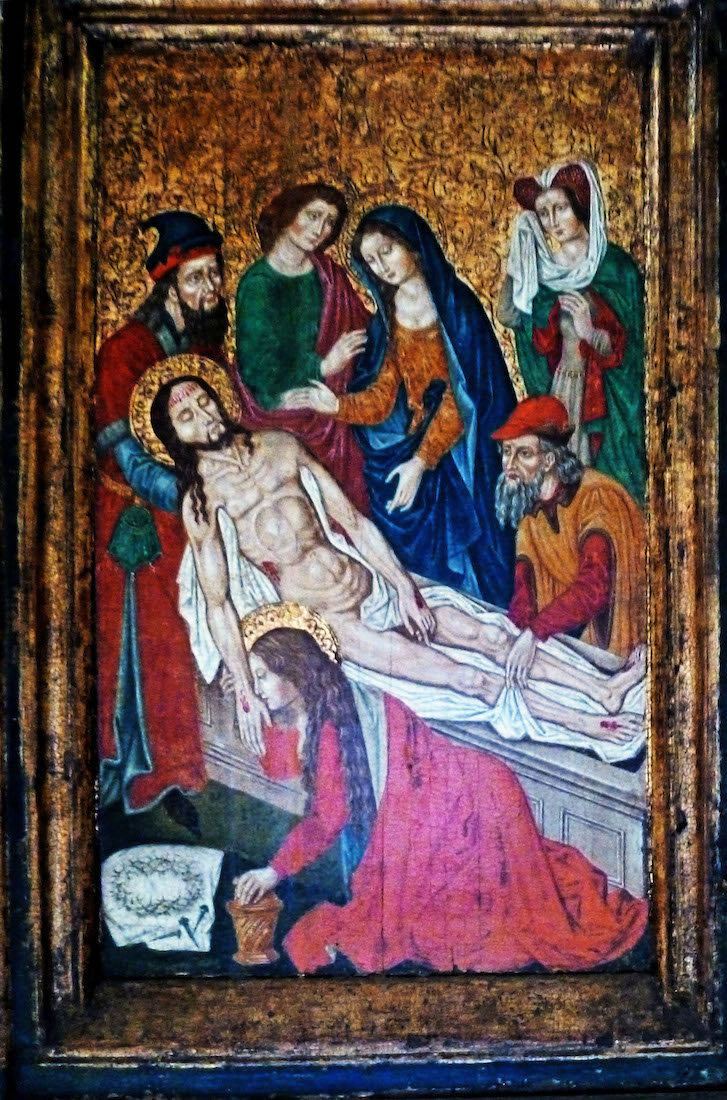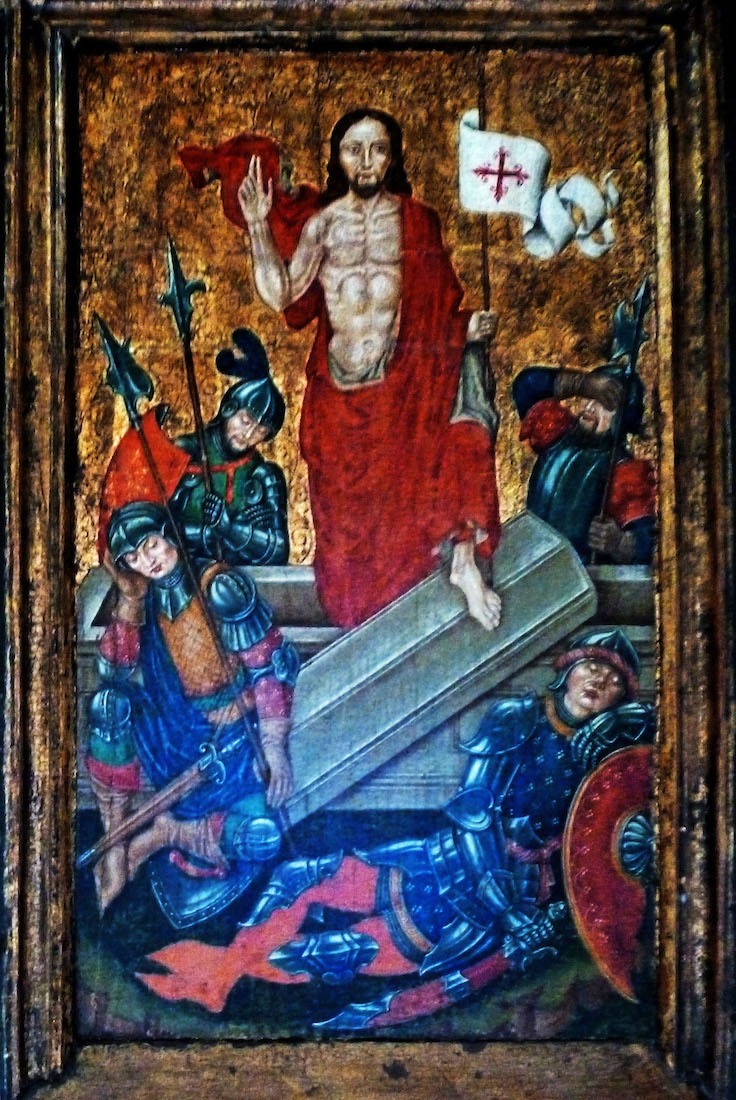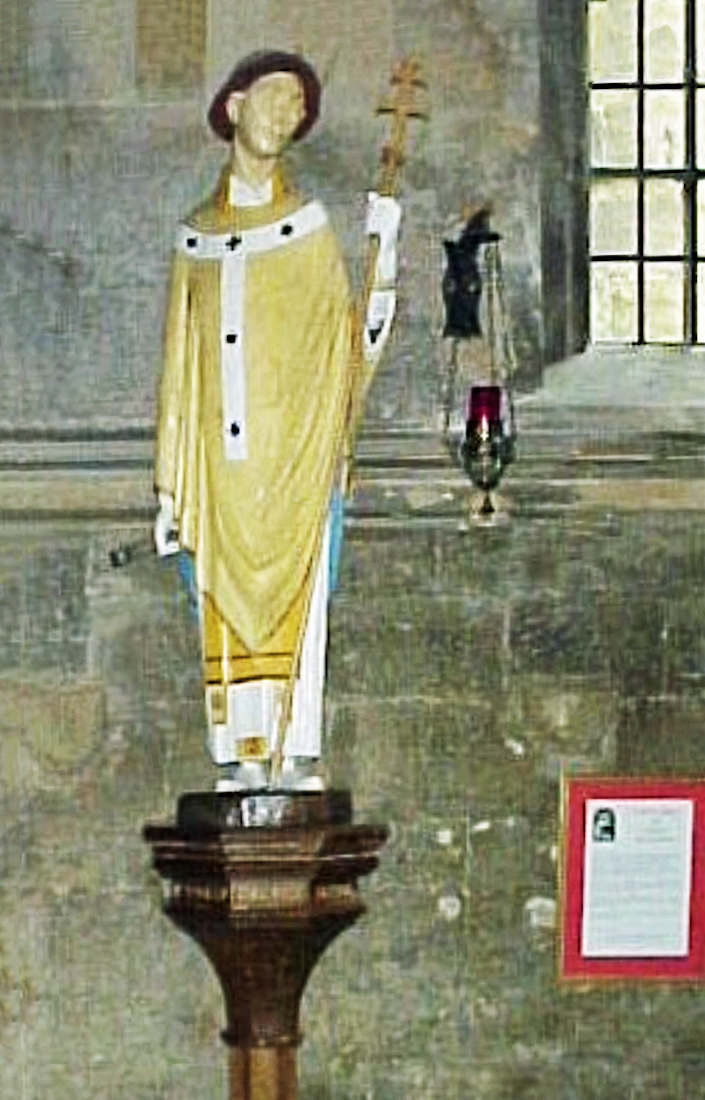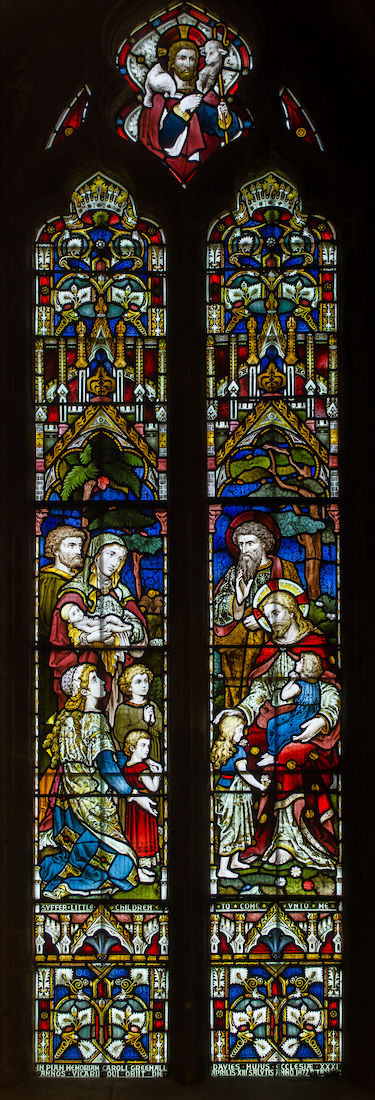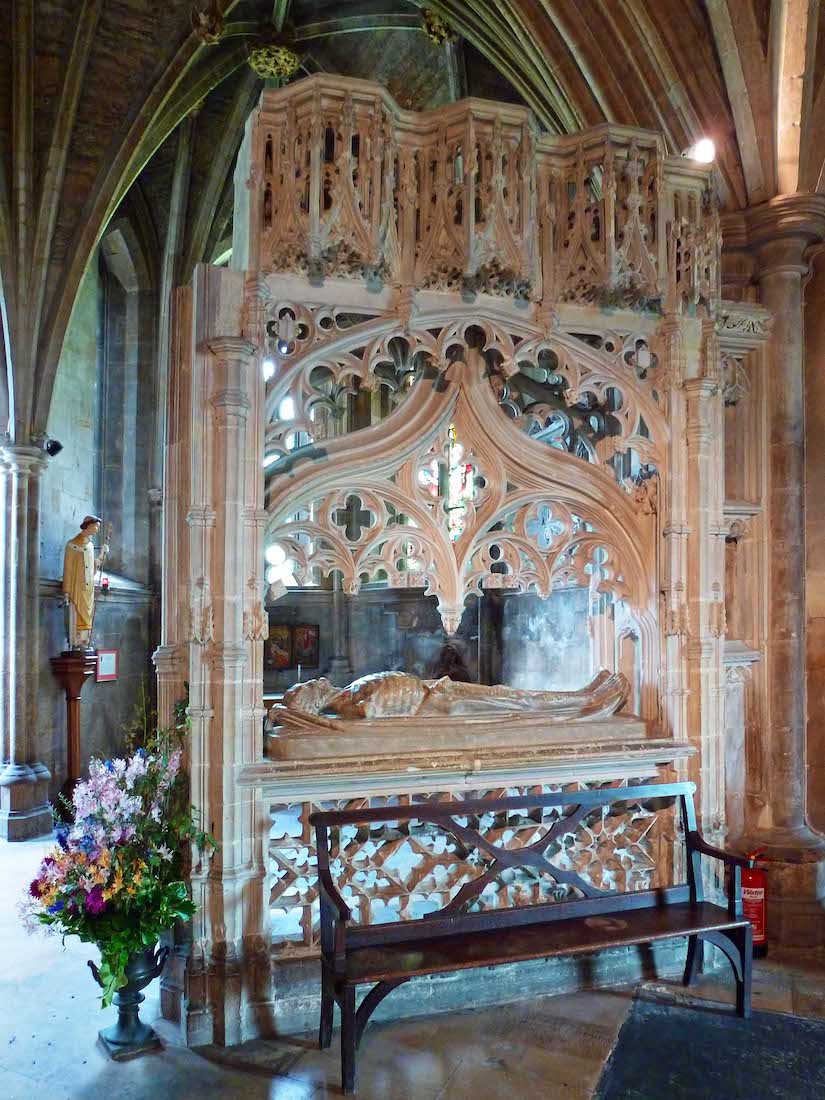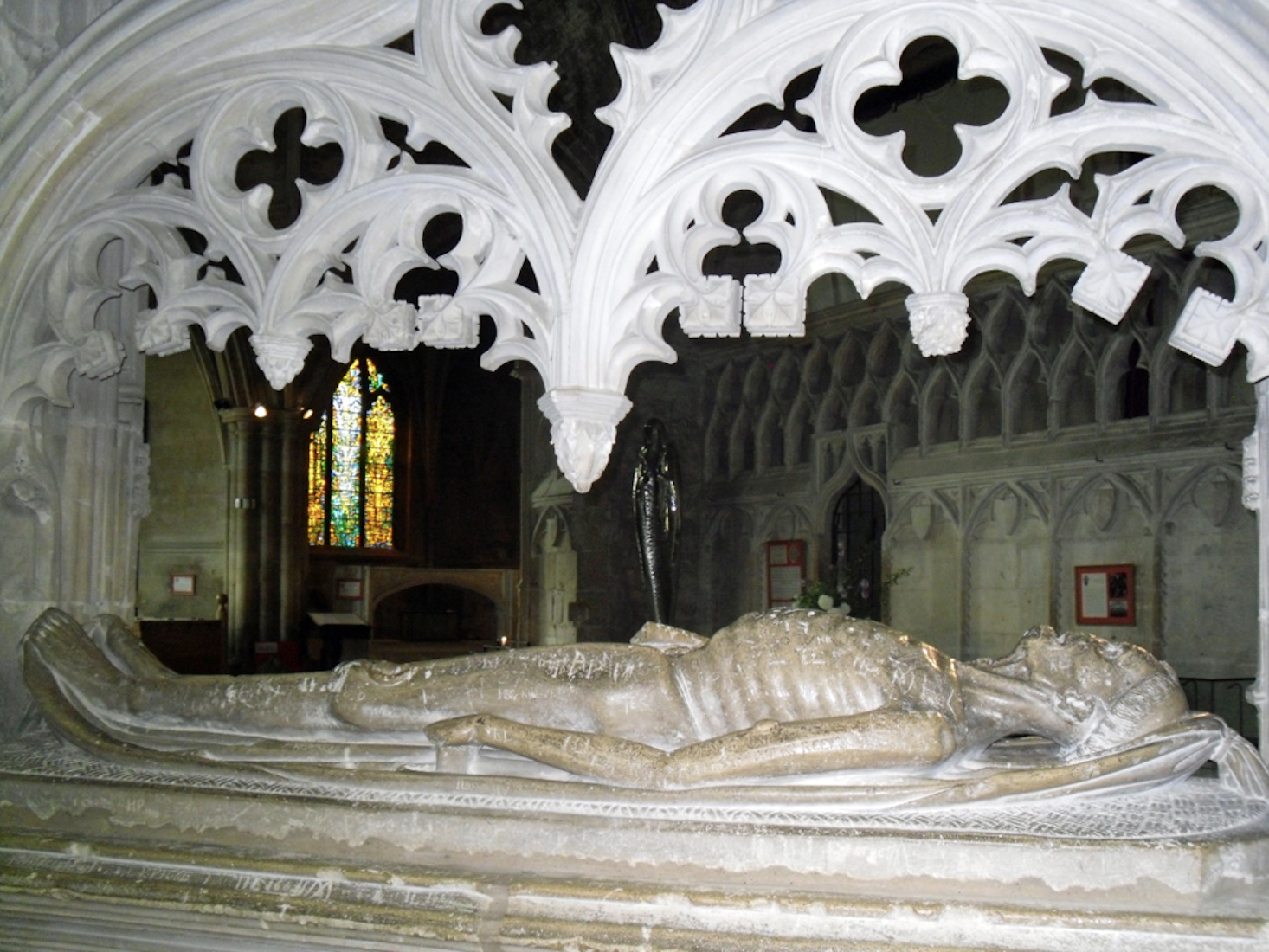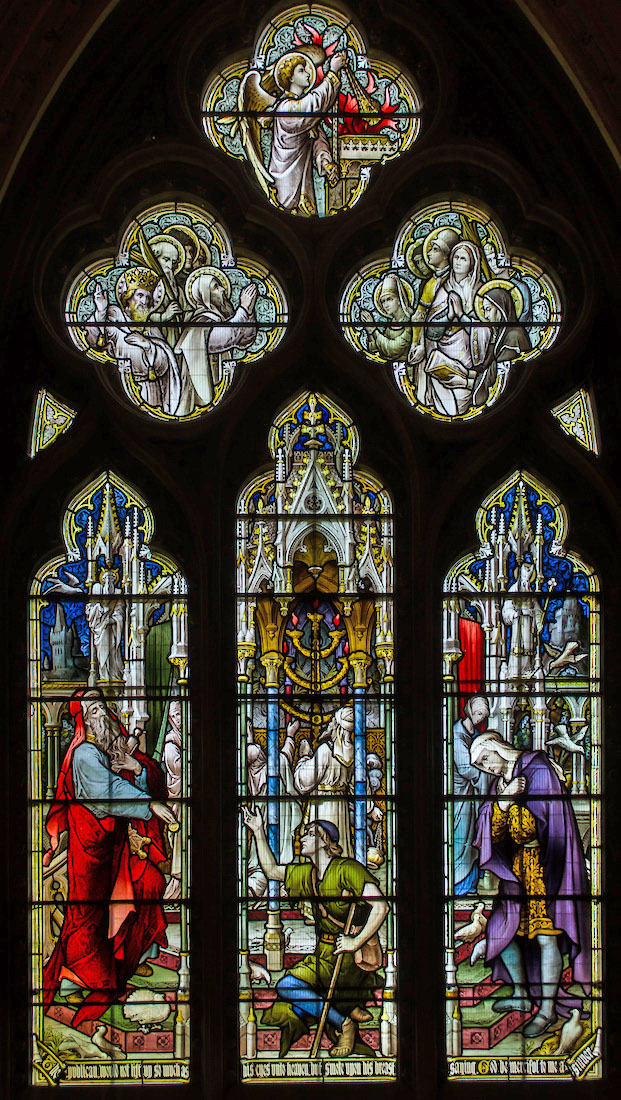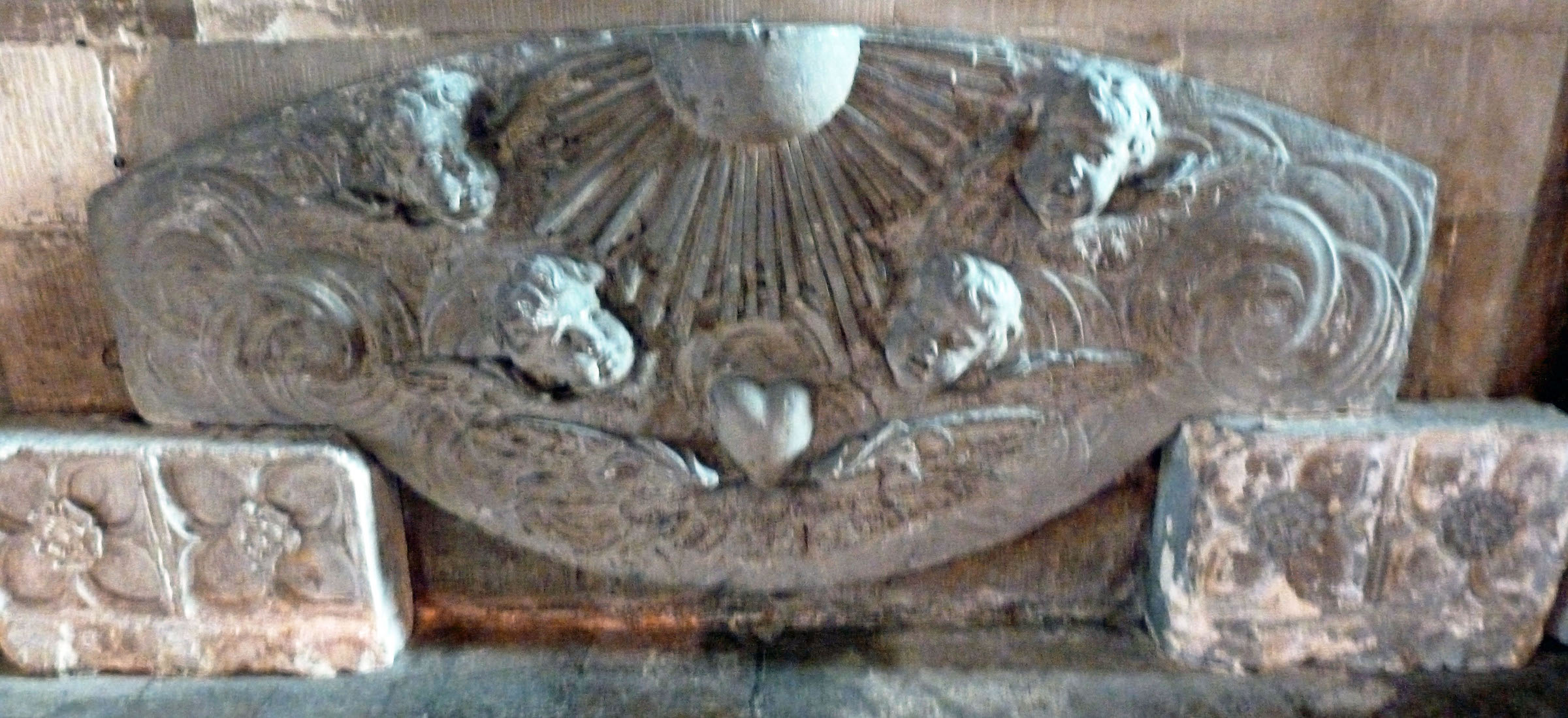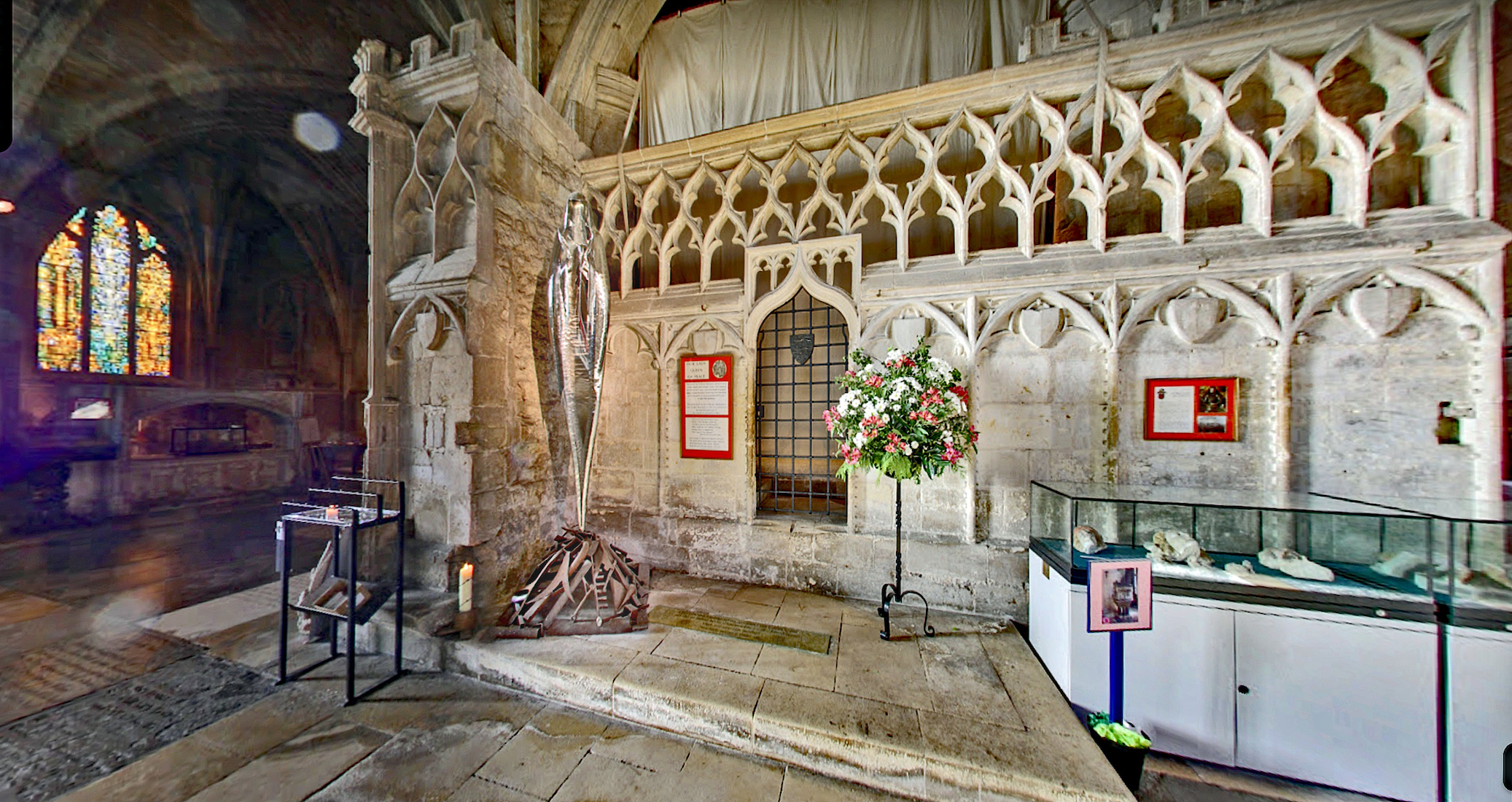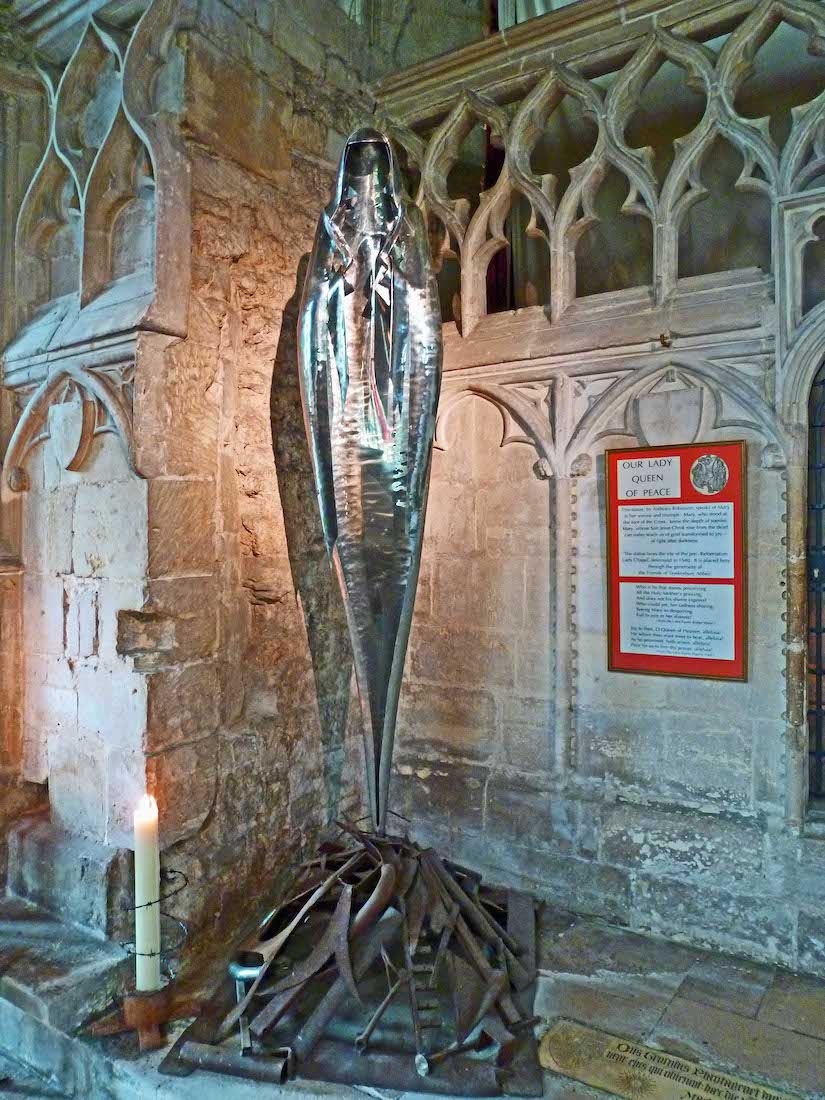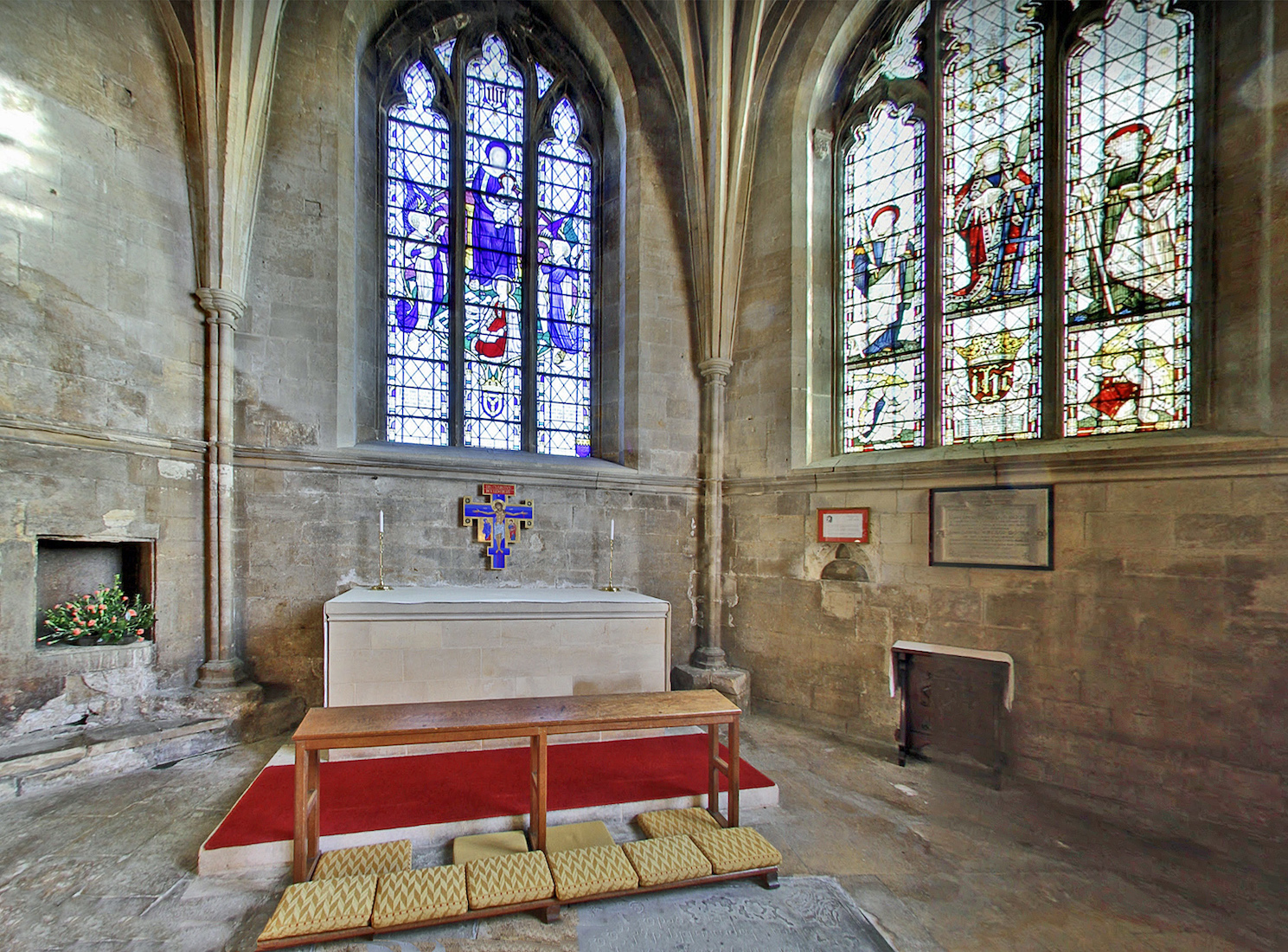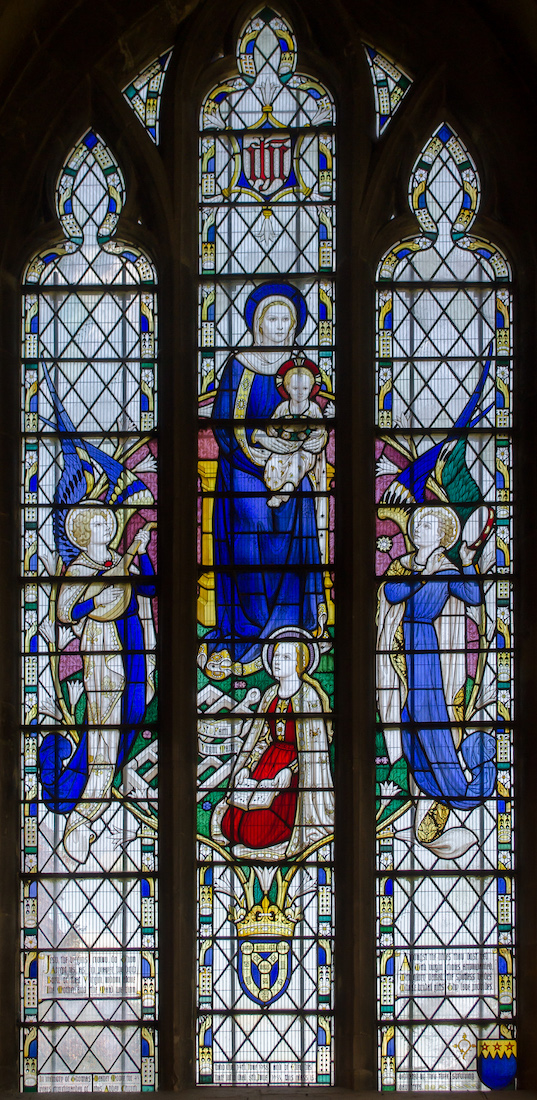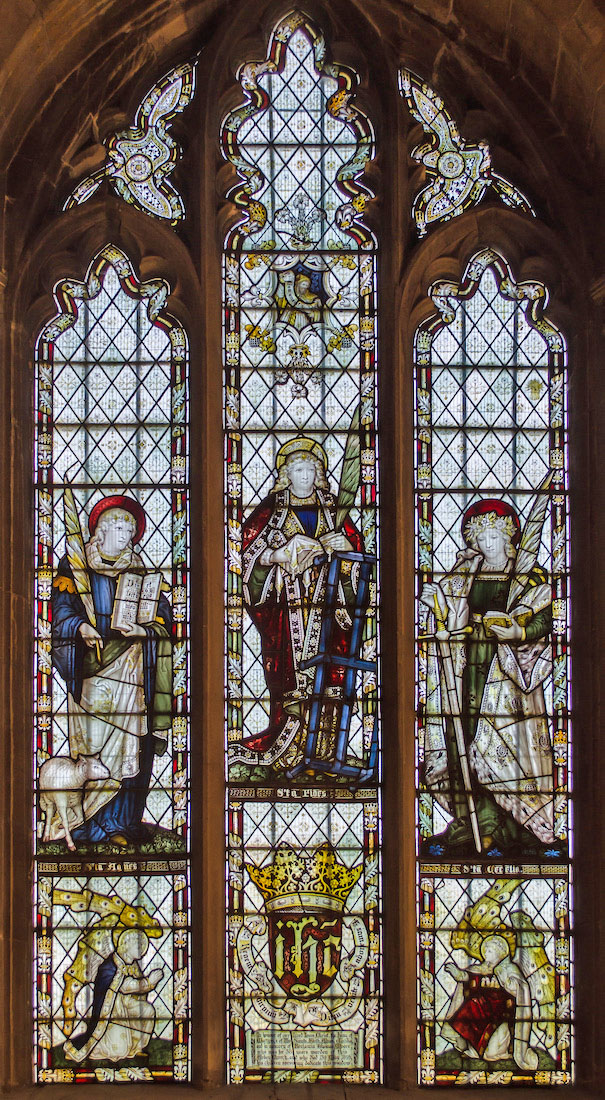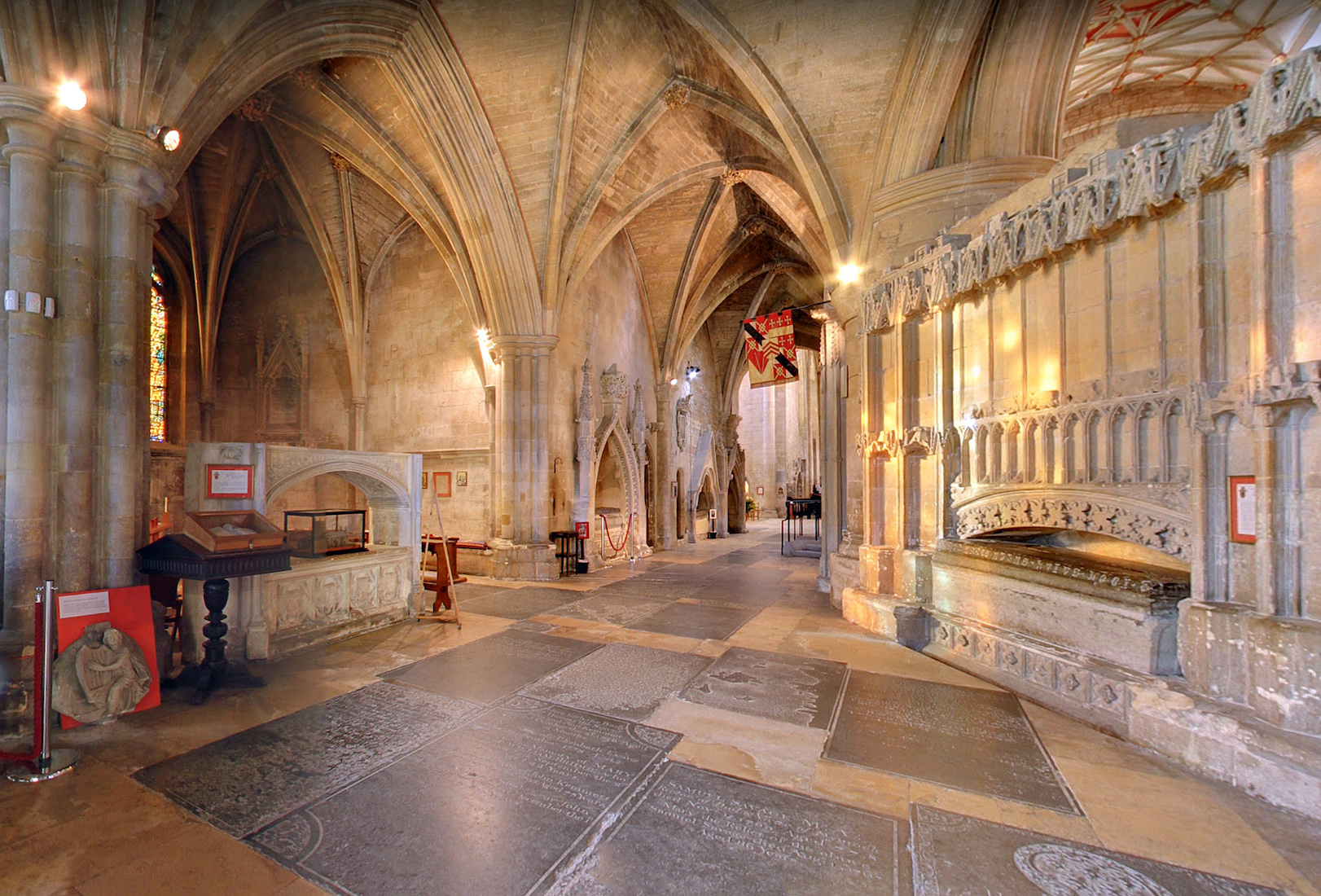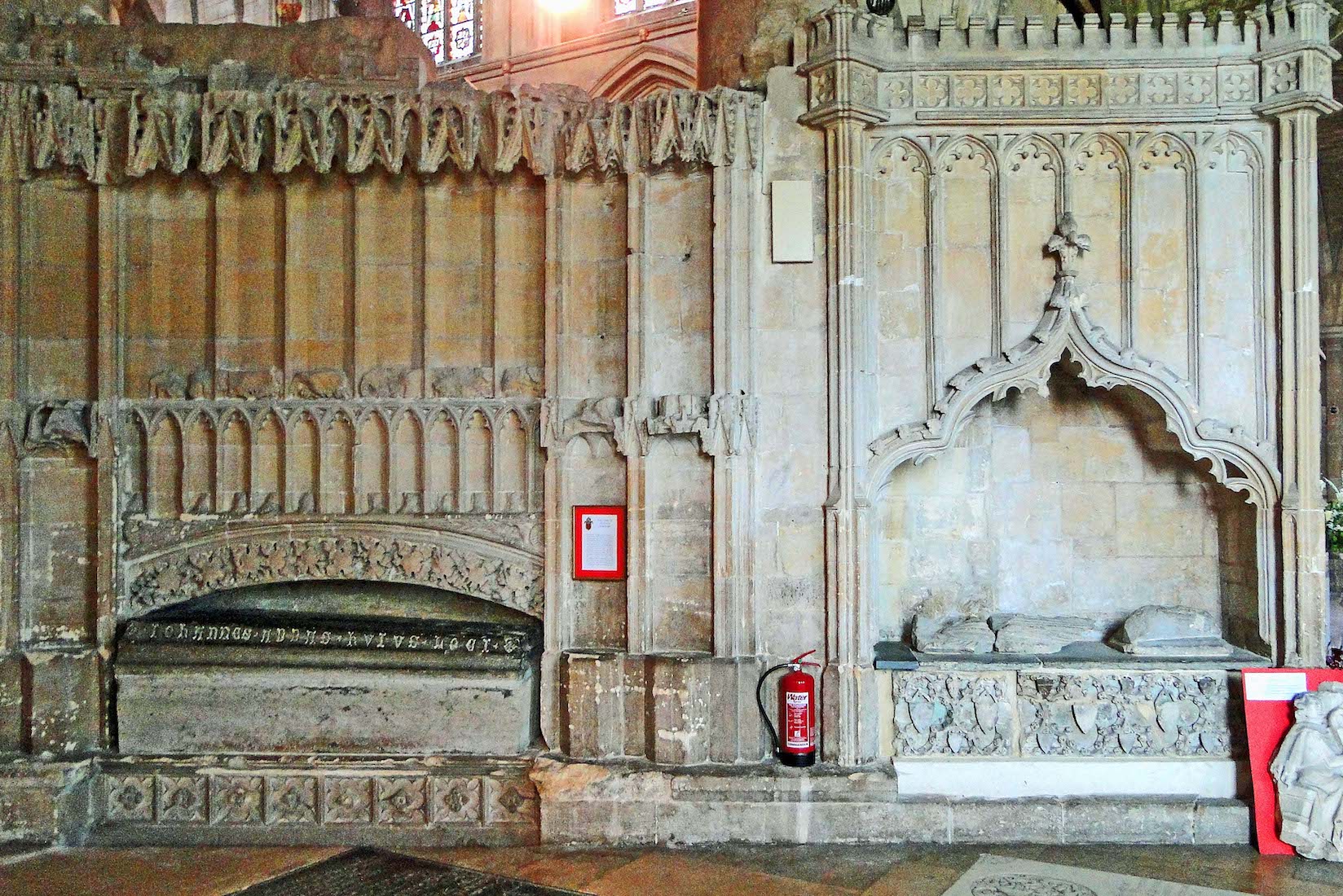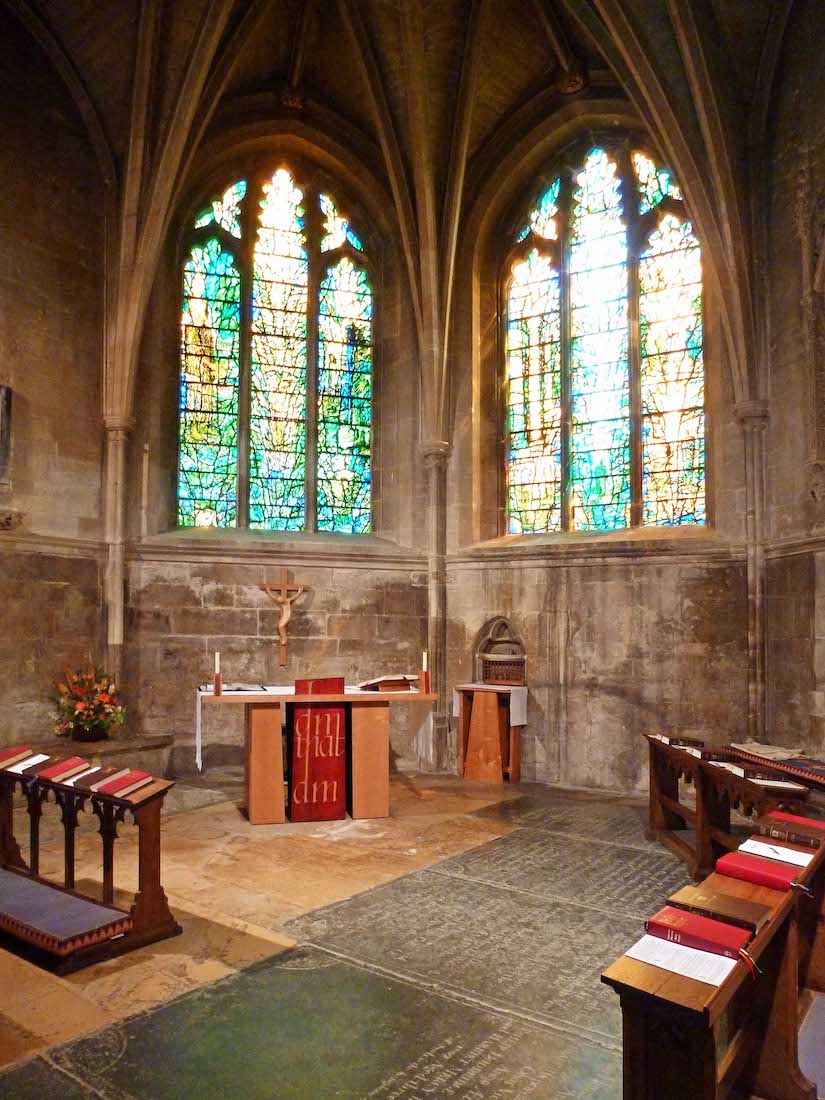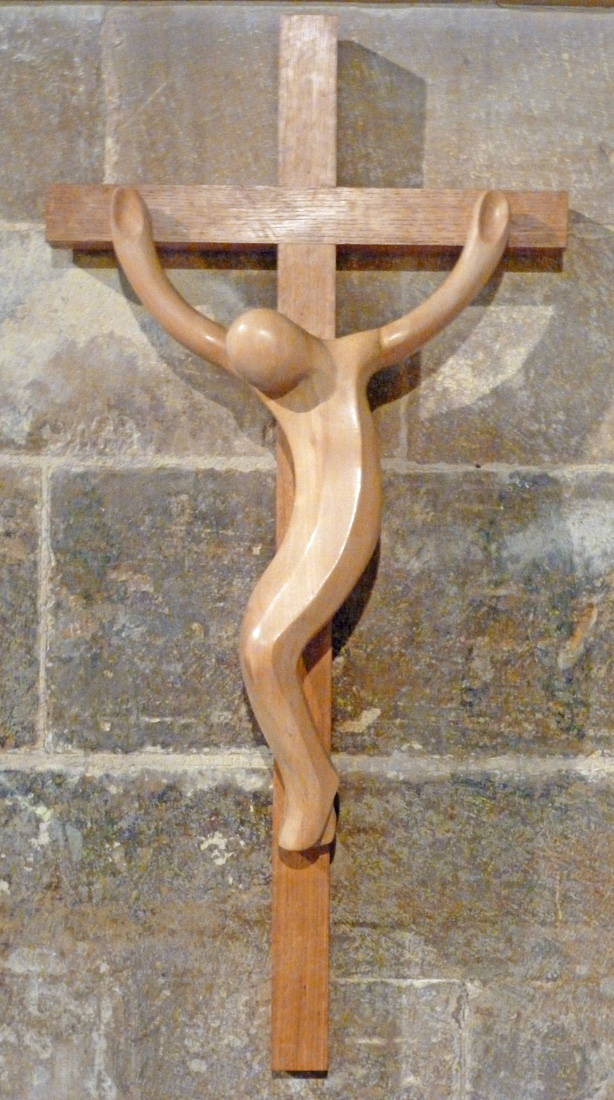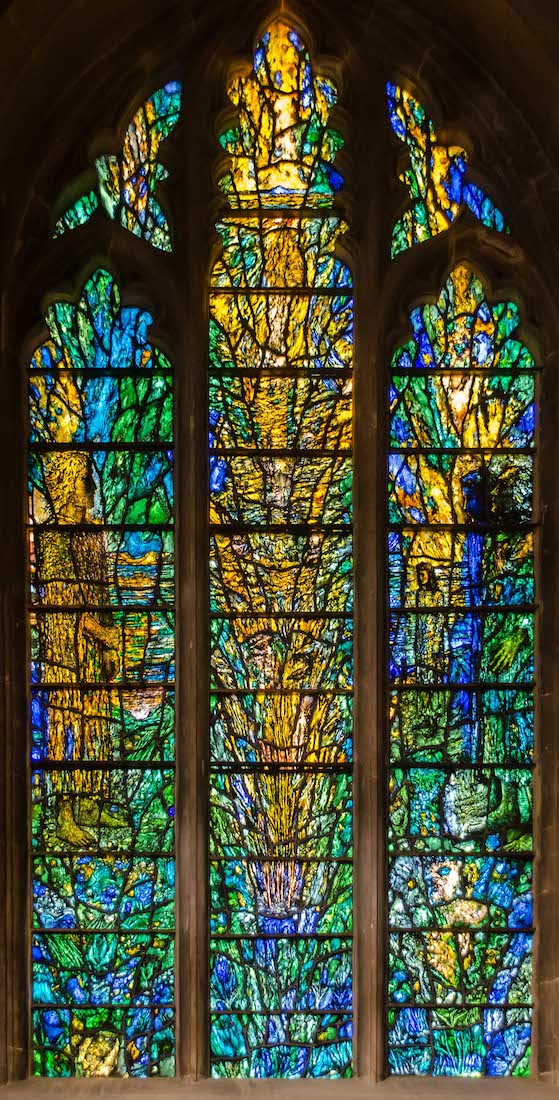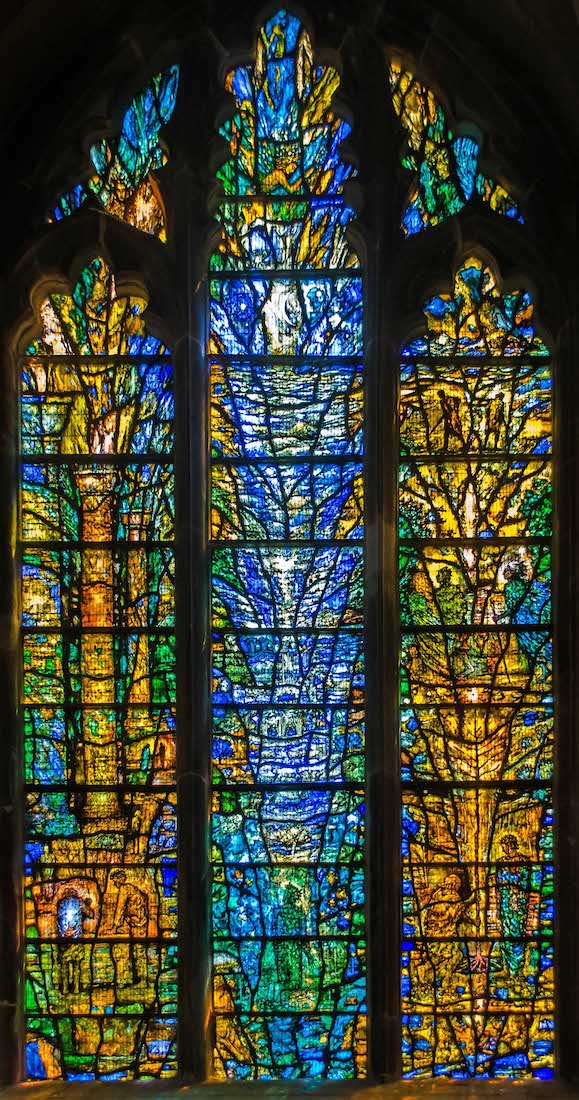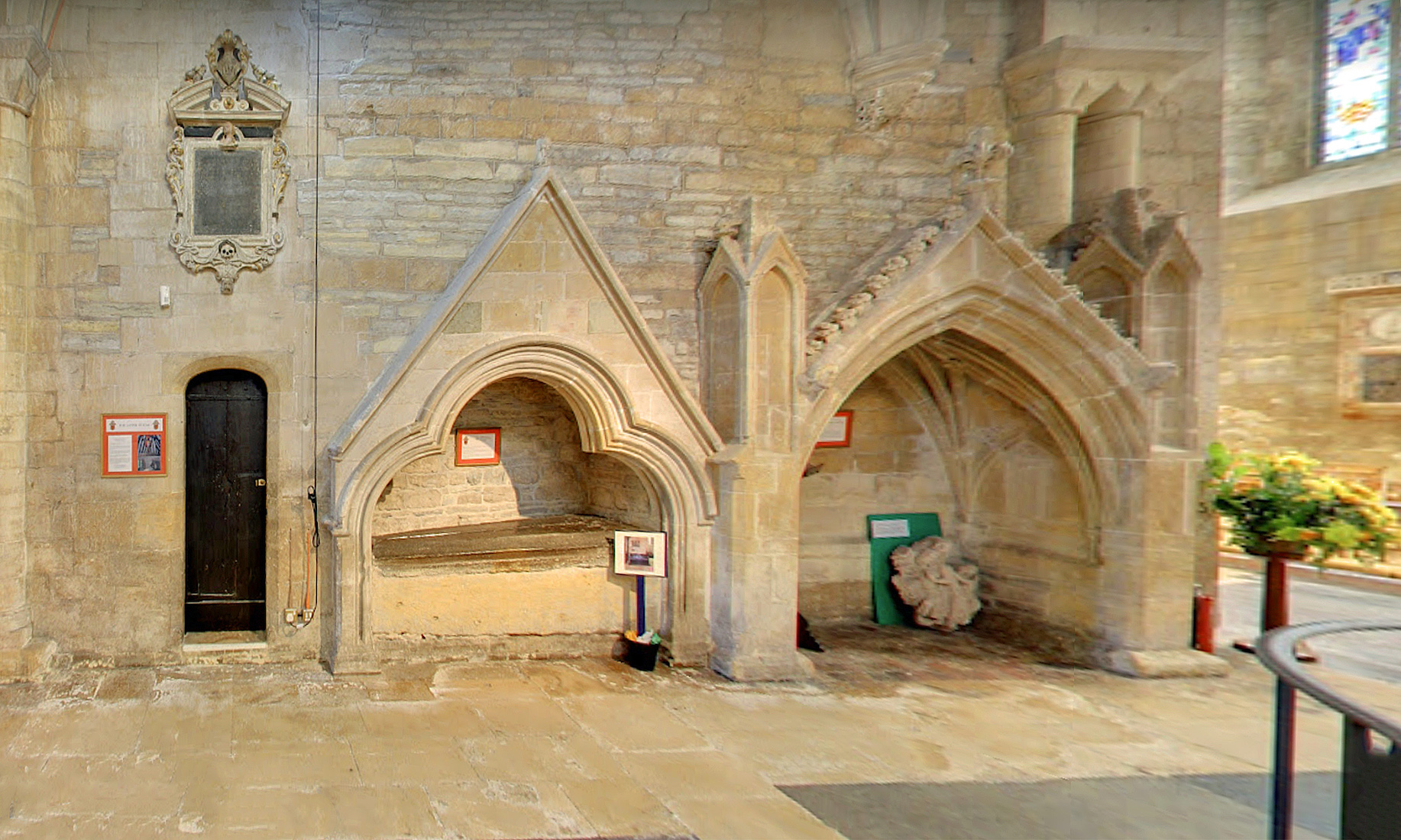61. TRIPTYCH IN ST EDMUND’S CHAPEL JL
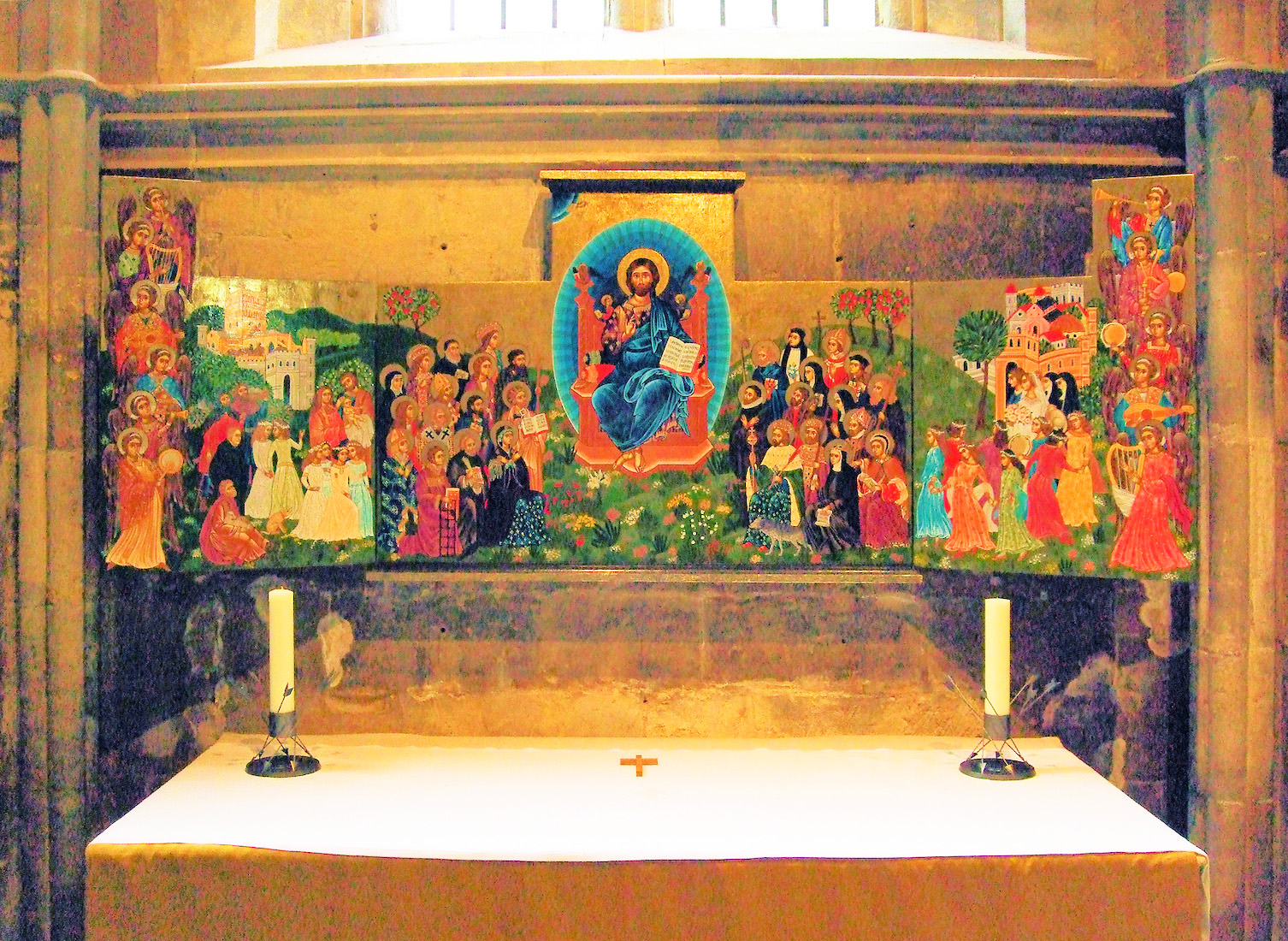
The next chapel we come to is a curious double-chapel dedicated to St Edmund and St Dunstan. Behind the St Edmund altar is a colourful triptych, created in 2013, depicting Jesus Christ, Jerusalem and Tewkesbury. The three-part painting features images associated with the town, such as mustard flowers and horseradish plants. Artist Silvia Dimitrova took two years to complete the triptych which was funded by The Friends of Tewkesbury Abbey. [Photo Credit: Flickr Jim Linwood] INDEX
62. ACROSS THE EAST END GSV
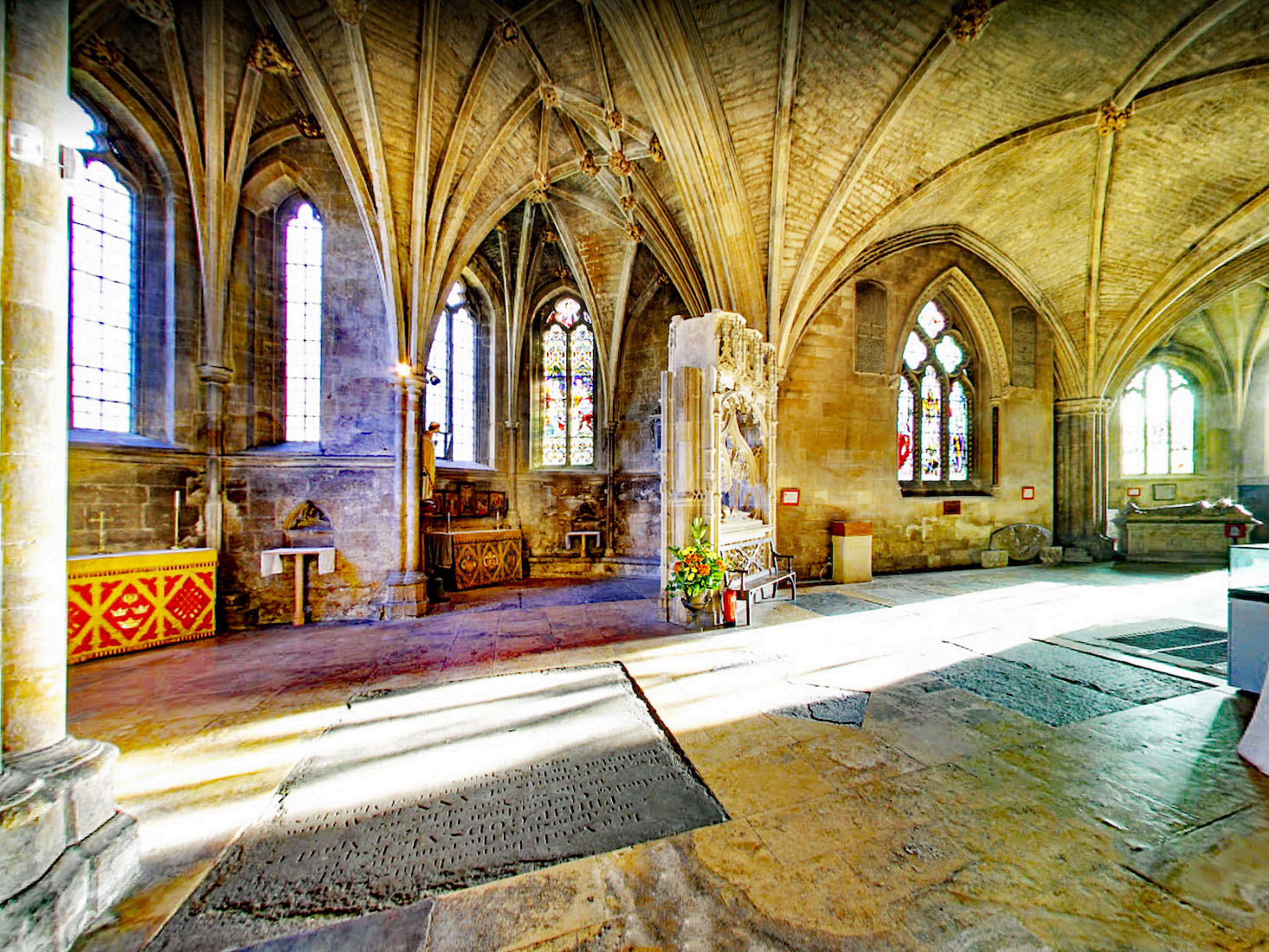
This view across the East end of the Abbey shows at left the arrangement of the two adjoining chapels of Saint Edmund and Saint Dunstan. Next to these is what appears to be an extending divider comprising an effigy lying on a tomb. The next flat wall with window is the place from where the Lady Chapel once connected. Beyond that, there are further chapels. We notice too that there are various carved memorial floor slabs. At right there is also an iron grating in the floor behind the high altar. This covers a stairway down to the Clarence Vault containing the bodies of George, Duke of Clarence (brother of Edward IV who was murdered in the Tower of London, reputedly by being drowned in a barrel of Malmsey wine) and his wife Isabel, daughter of Warwick the ‘King Maker’.
63. ST DUNSTAN’S CHAPEL ALTAR GA
The reredos above the small altar in St Dunstan’s Chapel is a reproduction of a 15th century Flemish painting showing the Passion of Christ.
64. CHAPEL ALTARPIECE PAINTINGS GA x5
Here are close-ups of the five panels. They show: •• Jesus healing the ear of the high priest after it was cut off by Peter; •• Jesus being mocked and tortured; •• the Crucifixion; •• the Descent from the Cross; •• and the Resurrection.
65. ST DUNSTAN TA J&J
In St Dunstan’s Chapel there is a statue of the saint. Saint Dunstan (c. 909 – 988) was an English bishop. He was successively Abbot of Glastonbury Abbey, Bishop of Worcester, Bishop of London and Archbishop of Canterbury, later canonised as a saint. His work restored monastic life in England and reformed the English Church. Dunstan served as an important minister of state to several English kings. He was the most popular saint in England for nearly two centuries, having gained fame for the many stories of his greatness, not least among which were those concerning his famed cunning in defeating the Devil. ••• The window in St Dunstan’s Chapel shows Jesus blessing the children, by Heaton, Butler & Bayne, 1879. It is in memory of Canon C. G. Davies, Vicar 1846-77 who died aged 73. [Photo1 Credit: Tewkesbury Abbey]
66. WAKEMAN EFFIGY GA WH
On the right of the St Dunstan’s Chapel is the Wakeman Cenotaph which has an elaborate canopy with a cadaver effigy lying on an open shroud. John Wakeman was the last Abbot of Tewkesbury, and was created first Bishop of Gloucester in 1541. He died in 1549, but it is unlikely there is a genuine connection of this tomb with him.
67. ABBEY EAST WINDOW J&J
This stained glass window is in the East wall of the Cathedral. It shows the Pharisee and the Publican, and is by Hardman & Co, 1887. The Pharisee, dressed in red, is giving alms to the beggar in green, whilst the publican (a tax collector) looks on. The story can be found in Luke 18:9-14. There is some sadness standing by this wall, as we might picture the long gone Lady Chapel which once stood here.
68. EAST END ANGELS GA
At the base of the East wall is a piece of broken masonry featuring a heart and the heads of several putti. Unfortunately I cannot read the nearby explanatory sign!
69. MARY QUEEN OF PEACE GSV-MJ
At the back of the high altar stands a modern sculpture known as ‘Our Lady Queen of Peace’. [Photo Credit: Mike James]
70. OUR LADY QUEEN OF PEACE, DETAIL GA
This statue by Anthony Robinson is also known as ‘Mary Queen of Peace’. It faces the site of the pre-Reformation Lady Chapel which was destroyed in 1540. A beautiful shiny statue of Mary rises from a pile of twisted and rusted metal. This illustrates that from grief and despair can come peace, beauty and hope.
71. ST FAITH CHAPEL GSV
Across the ambulatory from the Peace statue in the Southeast corner of the Abbey stands the St Faith Chapel.
72. CHAPEL CRUCIFIX GA
Behind the simple altar of the Faith Chapel is a large crucifix icon designed by Peter Murphy. The shape is an adapted ‘cross potent’ in which cross bars are added to the four ends of an heraldic cross. Two added side panels portray the figures of Jesus’ Mother, Mary, and John the Evangelist. The top cross bar has text which reads ‘Jesus of Nazareth, King of the Jews’.
73. CHAPEL WINDOWS J&J J&J
There are two stained glass windows in this Chapel. ••• The window at left has glass by Geoffrey Webb, made in 1941, showing The Virgin Mary and Christ Child with St Faith, surrounded by Angels playing a lute and a tambourine. The window is in memory of Thomas W. Moore (died 1938), and his wife Ellen (died 1933). ••• The window at right is a Kempe window from 1898, depicting Saints Agnes, Faith (with her bronze bed) and Cecilia with Martyr’s palms. The window is in memory of Benjamin Thomas Moore, who died in 1896.
74. SOUTH AMBULATORY GSV
This is the view looking down along the South ambulatory. There is one further chapel to the left, separated from the ambulatory by a model of the Abbey. There are several wall niches to be explored, including one just to our right which is out of view here. And again we notice the various memorial floor slabs, reflecting the long history of the Abbey.
75. AMBULATORY TOMBS WH
These two tombs are on our right as we begin our walk back along the South ambulatory. ••• At left is a much mutilated tomb of Hugh Despenser (died 1326): the empty little niches above have contained many images. The coffin is unrelated, being that of John Cotes who was Abbot 1328 – 1347. It is made of Purbeck marble and has a very clear inscription. ••• At right is the tomb of an unknown person, with a mutilated effigy.
76. ST CATHERINE AND ST JOHN THE BAPTIST CHAPEL GA GA
We come next on our left to the Chapel of St Catherine and St John the Baptist, best known for the two modern windows by Tom Denny, which were created in 2002 to mark the 900th anniversary of the coming of the Benedictine monks to Tewkesbury in 1102. Notice too the modern crucifix.
77. TOM DENNY WINDOWS J&J J&J
These windows by Tom Denny depict ‘Prayer’. In fact their motto is ‘To work is to pray’. The style is undeniably modern, but Denny has picked up the colours of the 14th century glass above the choir, some of which is visible from the chapel.
78. CHAPEL ICONS GA GA
On the South wall of the Chapel are large iconic paintings of St John the Baptist and St Catherine. In the left icon we notice the rather gruesome head in the chalice – the work of Herod the King, and at right the ‘Catherine wheel’ on which St Catherine was put to death.
79. FORTHINGTON MONUMENT GCM
We leave the Chapel of St John the Baptist and St Catherine, and continue West along the South ambulatory. On our left is the Abbot Robert Forthington monument (1254): a Purbeck marble coffin slab. There is in fact a small figure in low relief within the head of a foliated cross on the slab. [Photo Credit Gazetteer of Church Monuments]
80. SOUTH AMBULATORY TOMBS GSV
Passing the sanctuary door, there are two more memorials. ••• First at left the tomb of Abbot Alan (1202), who was the biographer of Thomas Becket. The coffin has a Purbeck marble top with a foliated cross. ••• Then at right there is a tomb with no chest or effigy.


